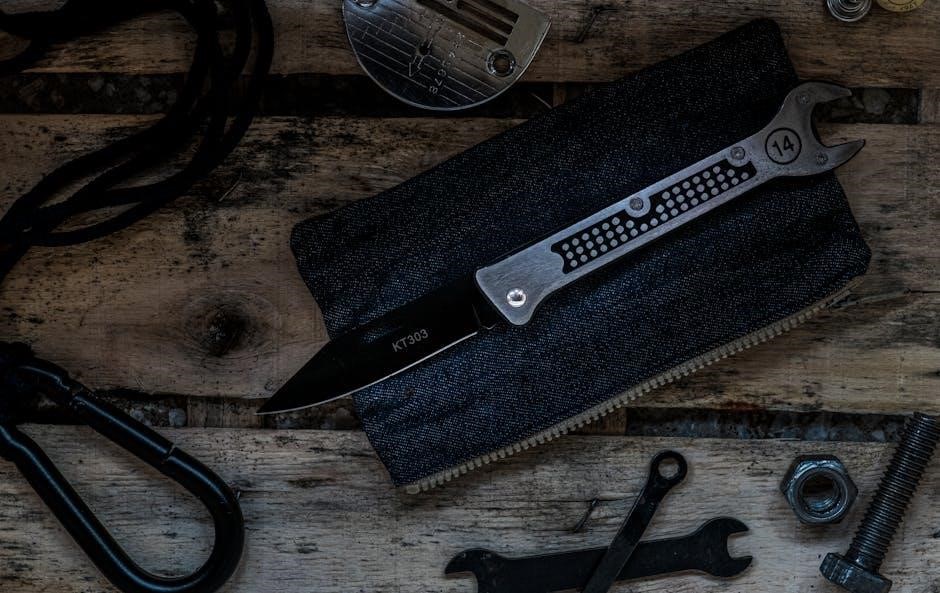Pocket hole screws are essential for strong, invisible joints in woodworking, ideal for furniture and cabinetry․ They come in various sizes, with #8 and #10 diameters being common for 2x4s, balancing strength and minimizing wood splitting․ Coarse threads enhance softwood grip, while appropriate screw lengths ensure secure joints without protrusion, typically around 2 inches for 2x4s․ Choose #8 for general use and #10 for heavier applications, ensuring project durability and stability․
What Are Pocket Hole Screws?
Pocket hole screws are specialized fasteners designed for creating strong, hidden joints in woodworking projects․ They feature a unique tapered shank and coarse threads that provide excellent grip in wood․ Unlike standard screws, pocket hole screws are used in conjunction with pocket hole jigs, which drill angled holes to guide the screw into place․ This system allows woodworkers to assemble joints without visible hardware, making it ideal for furniture, cabinetry, and other woodworking applications․ The screws are available in various diameters and lengths to suit different materials and project requirements․ Their self-tapping design eliminates the need for pilot holes, while the large, flat head ensures a secure hold․ Pocket hole screws are particularly popular for their strength and versatility, making them a go-to choice for both professionals and DIY enthusiasts․ They are compatible with a wide range of wood types, including hardwood, softwood, and engineered materials like plywood and MDF․
Why Use Pocket Hole Screws?
Pocket hole screws are a popular choice in woodworking due to their ability to create strong, hidden joints with minimal effort․ They eliminate the need for clamps by securely holding materials together during assembly․ This makes them ideal for furniture, cabinetry, and shelving projects where a clean, professional finish is desired․ The screws are designed with coarse threads that provide excellent grip in various wood types, ensuring durability and stability․ Their versatility allows use in both hardwood and softwood, as well as engineered materials like plywood and MDF․ Pocket hole screws are also time-saving, as they simplify the assembly process without requiring complex joinery techniques․ Additionally, they are easy to disassemble if needed, making them practical for projects that may require future adjustments․ Overall, pocket hole screws offer a balance of strength, ease of use, and aesthetic appeal, making them a valuable tool for woodworkers of all skill levels․

Understanding Screw Sizes
Pocket hole screws are available in various diameters and lengths, with #8 and #10 being the most common for 2x4s․ Proper sizing ensures strength and minimizes wood splitting, while length options accommodate different materials and project needs․
Common Diameters: #6, #8, #10
Pocket hole screws are available in various diameters, with #6, #8, and #10 being the most common․ The #8 diameter is widely used for general woodworking projects, offering a balance of strength and minimal wood splitting․ For lighter applications or thinner materials, the #6 diameter is ideal, providing sufficient hold without excessive bulk․ On the other hand, the #10 diameter is preferred for heavier constructions or dense hardwoods, ensuring maximum stability and durability․ These standard sizes are designed to accommodate different project requirements, making them versatile for furniture, cabinetry, and structural assemblies․ Choosing the right diameter ensures optimal performance and prevents common issues like splitting or insufficient hold․ By selecting between #6, #8, or #10, woodworkers can tailor their screws to the specific demands of their projects, achieving professional-grade results every time․
Length Options for Different Projects

The length of pocket hole screws varies to suit different applications, ensuring proper penetration without splitting the wood․ For standard 2×4 lumber, a 2-inch screw is typically recommended, providing adequate strength and preventing over-protrusion․ Thinner materials, such as plywood or MDF, may require shorter screws, around 1 inch, to avoid splitting․ Conversely, for heavier constructions or denser hardwoods, longer screws, such as 2․5 inches or more, are ideal to ensure a secure hold․ The screw length should align with the thickness of the material being joined, allowing the tip to exit just before the far side of the second piece․ This ensures a flush, invisible joint․ Proper length selection is critical for both functionality and aesthetics, preventing issues like weak joints or visible screw tips․ By matching the screw length to the project’s requirements, woodworkers can achieve strong, professional-grade results every time․

Materials and Screw Selection
Choose screws based on wood type and project needs․ Hardwoods require longer screws for strength, while softwoods need shorter ones to prevent splitting․ Engineered woods like plywood and MDF often use coarse-thread screws for better grip․
Wood Type: Hardwood vs․ Softwood
The type of wood significantly influences screw selection․ Hardwoods, like oak and maple, are denser and require screws with longer lengths and finer threads to ensure proper hold without splitting․ Softwoods, such as pine and spruce, are less dense and may require shorter screws with coarser threads to prevent over-penetration and splitting․ For hardwoods, a #8 or #10 screw is ideal, while softwoods often work well with #6 or #8 screws․ When working with hardwoods, consider using screws with a sharp point to minimize splitting, and always pre-drill pilot holes for precise alignment and to reduce the risk of wood damage․ Coarse-thread screws are particularly effective in softwoods, as they provide a stronger grip without compromising the material’s integrity․ Matching the screw to the wood type ensures a durable and professional-looking joint․
Engineered Woods: Plywood, MDF, Chipboard
Engineered woods like plywood, MDF, and chipboard require specific screw sizes for optimal performance․ These materials are softer and more prone to splitting, so coarse-thread screws are ideal․ For plywood, a #8 or #10 screw works well, while MDF and chipboard benefit from smaller diameters like #6 or #8 to avoid material breakdown․ Screw lengths should be sufficient to hold the joint securely without over-penetrating, typically ranging from 1․25″ to 1․5″․ When working with engineered woods, pre-drilling pilot holes is highly recommended to prevent splitting and ensure precise alignment․ Coarse-thread screws are particularly effective in these materials, as they provide a strong grip without compromising the wood’s integrity․ Always consider the thickness of the material and the weight it will support when selecting screw size and type․ Proper selection ensures a durable and stable joint, making engineered woods a reliable choice for various woodworking projects․

Project-Specific Screw Requirements
Project-specific screw requirements vary based on material thickness and weight․ Common diameters like #8, #9, and #10 are ideal for 2x4s, while engineered woods and heavy-duty applications may need larger or coarse-thread screws for added strength and stability․
Furniture and Cabinetry
Furniture and cabinetry projects often require precise screw selection to ensure durability and stability․ For most applications, #8 or #10 screws are ideal, offering a balance between strength and minimal wood splitting․ When working with 1×2 or 1×4 lumber, a 1-1/4″ to 1-1/2″ screw length is typically sufficient, while thicker materials may require longer screws for secure joints․
For finer materials like MDF or plywood, coarse-thread screws are recommended to prevent stripping and ensure a strong hold․ In cabinetry, shorter screws (1″ to 1-1/4″) are often used for attaching backs and shelves, while longer screws (1-1/2″ to 2″) are better for frame assembly․ Proper pre-drilling and using a pocket hole jig can help avoid splitting, especially in softer woods․ Always match the screw size to the material thickness to achieve professional results and long-lasting furniture pieces․
Decking and Outdoor Structures
When building decking and outdoor structures, selecting the right pocket hole screws is crucial for durability and weather resistance․ For decking, #8 or #10 screws with a coarse thread are ideal, as they provide a strong grip in softer materials like pressure-treated lumber․ Ensure screws are weather-resistant, such as galvanized or stainless steel, to withstand moisture and outdoor conditions․ Screw lengths should be sufficient to secure the joint without over-protruding, typically ranging from 2″ to 3″ for decking boards․ For heavier outdoor structures like pergolas or gazebos, use longer screws (3″ to 4″) to handle increased load-bearing requirements․ Always pre-drill to avoid splitting, especially in dense hardwoods․ Using a pocket hole jig ensures accurate alignment and consistent results․ Proper screw selection and technique are essential for building sturdy, long-lasting outdoor projects that can endure harsh weather conditions and heavy use․

Heavy-Duty and Load-Bearing Applications
For heavy-duty and load-bearing projects, pocket hole screws must be chosen with care to ensure maximum strength and stability․ In such applications, screw size and material are critical․ A #10 or larger diameter screw is often recommended, as it provides a stronger hold in dense materials․ Screw length should be sufficient to securely fasten the joint, typically ranging from 4″ to 5″ for heavy-duty tasks․ Coarse-thread screws are ideal for softer woods, while fine-thread screws perform better in hardwoods․ For load-bearing structures, such as beams or supports, consider using screws with a hardened steel core for added durability․ Galvanized or stainless steel screws are excellent choices for outdoor or high-moisture environments․ Always pre-drill pilot holes to prevent splitting and ensure proper alignment․ Using a high-quality pocket hole jig is essential for precise results․ By selecting the right screw size and type, you can create robust joints capable of withstanding significant weight and stress․

Best Practices for Using Pocket Hole Screws
For optimal results, ensure precise pre-drilling, use a jig for alignment, and clamp workpieces firmly․ Drive screws flush to the surface and avoid over-tightening to maintain material integrity and prevent splitting․
Drilling Techniques
Proper drilling techniques are crucial for successful pocket hole joinery․ Always use a pocket hole jig to ensure accurate and consistent hole placement․ Drill at a 15-degree angle to maximize joint strength․ Maintain steady pressure and use a drill bit specifically designed for pocket holes to avoid uneven holes․ Pre-drill pilot holes to prevent wood splitting, especially in hardwoods․ Use the correct drill bit size to match your screw diameter for optimal results․ Keep the drill bit sharp to minimize tear-out and ensure smooth drilling․ Adjust your drill speed according to the material—slower for hardwoods and faster for softwoods․ Clamp the workpiece firmly to prevent movement during drilling․ Proper alignment and depth control are essential to achieve professional-looking joints․ Following these techniques ensures strong, durable connections and prevents common issues like misaligned screws or split wood․ By mastering these drilling techniques, you can achieve precise and reliable results in your woodworking projects․
Driving Screws: Tips and Tricks
Driving screws effectively is key to ensuring strong and durable joints․ Always use the correct driver bit to avoid stripping the screw head․ Start by driving the screw at a slight angle to guide it into the pilot hole, then straighten it for full insertion․ Apply steady, consistent pressure to prevent over-tightening, which can damage the surrounding wood or strip the screw․ Use a screwdriver or drill with a torque setting to maintain control․ Keep the workpiece clamped firmly to prevent movement during driving․ For screws near edges, countersink slightly to avoid splitting the wood surface․ Avoid overdriving, as this can weaken the joint․ Use high-quality screws designed for your specific material, such as coarse-thread screws for softwoods or fine-thread for hardwoods․ Regularly clean and maintain your drill and driver bits to ensure smooth operation․ By following these tips, you can achieve secure, professional-looking joints in your woodworking projects․

Frequently Asked Questions
-
What Screw Size for 2x4s?
#8 or #10 screws are ideal for 2x4s, balancing strength and minimizing wood splitting․
-
Can Pocket Hole Screws Be Used Outdoors?
Yes, but use weather-resistant screws to prevent rust and ensure durability in outdoor conditions․
-
Why Do Screws Sometimes Split the Wood?
Splitting occurs from incorrect screw size, over-tightening, or drilling without a pilot hole․
For 2x4s, which are 1․5 inches by 3․5 inches in cross-section, the ideal screw size is either #8 or #10․ The #8 screw is a good all-purpose choice, offering sufficient strength without being overly bulky․ The #10 screw is slightly larger and is recommended for heavier applications or when using harder woods․ Screw length is also important; a 2-inch screw is typically appropriate for 2x4s, ensuring the joint is secure and the screw does not protrude․ Coarse-thread screws are preferable for softer woods like pine, while fine threads are better suited for harder woods․ Additionally, consider the screw material: galvanized or zinc-coated screws are best for outdoor use to resist rust, while regular steel screws are suitable for indoor projects․ Proper drilling techniques, such as using the correct drill bit and clamping the wood, help prevent splitting and ensure strong joints․ Consulting specific product recommendations can provide further practical insights and tips for successful use of pocket hole screws with 2x4s․
Pocket hole screws can be used outdoors, but it’s crucial to select the right type to withstand environmental conditions․ Galvanized or stainless steel screws are recommended due to their resistance to rust and corrosion․ Galvanized screws have a zinc coating that protects against moisture, while stainless steel offers superior protection, especially in coastal or high-humidity areas․ When using pressure-treated wood, opt for corrosion-resistant screws, as the chemicals in the wood can accelerate metal corrosion․ Coarse-thread screws may provide a better grip in softer woods, reducing the risk of loosening over time․ Look for screws specifically labeled as “outdoor” or “weather-resistant․” Ensure the screw’s entire fastener is made of the same corrosion-resistant material to avoid weak points․ Regular maintenance, such as applying a waterproof sealant, can further protect both the screws and the wood․ While alternatives like bolts and nuts exist, pocket hole screws offer convenience and invisibility, making them a viable choice for outdoor projects with proper selection and care․
Screws can split wood due to several factors, primarily related to the screw’s size and the wood’s type․ Softwoods, like pine, are more prone to splitting than hardwoods because of their less dense structure․ Using a screw that’s too large or too small for the wood can cause improper fit, leading to splits․ Drilling pilot holes of the correct size is essential to guide the screw straight and avoid binding․ The angle of drilling also matters; screws inserted at an angle increase the risk of splitting․ Coarse-thread screws are better suited for softer materials, reducing the likelihood of splits․ Over-tightening can also cause wood to split by applying excessive pressure․ To prevent splitting, ensure the screw size matches the wood type, drill straight pilot holes, and avoid over-tightening․ Using appropriate screws and techniques helps maintain the integrity of the wood and ensures strong, durable joints․

Tools and Accessories
Pocket hole jigs, like the UJK Pocket Hole Jig, are essential for precise drilling․ Drill bits and drivers ensure accurate screw placement, while clamps help maintain alignment․ These tools enhance efficiency and joint strength․
Pocket Hole Jigs

Pocket hole jigs are indispensable tools for woodworking, enabling precise and consistent drilling of pocket holes․ These jigs ensure that screws are correctly aligned, preventing errors and enhancing joint strength․ Models like the UJK Pocket Hole Jig offer versatility, allowing users to create frames quickly for furniture, kitchen fittings, and more․ They eliminate the need for clamping, speeding up the assembly process․ Whether you’re a professional or a DIY enthusiast, a good jig is crucial for achieving professional-grade results․ By guiding the drill bit accurately, it helps maintain material integrity, reducing the risk of wood splitting․ This tool is a cornerstone in modern woodworking, making pocket hole joinery accessible and efficient for projects of all sizes․
Drill Bits and Drivers
Drill bits and drivers are crucial for effectively using pocket hole screws․ A high-quality drill bit ensures precise pocket holes, while the correct driver guarantees secure screw installation․ For most applications, a #8 or #10 driver is used, matching the screw head size․ Coarse-thread screws work well with softer materials like pine, while finer threads may be better for hardwoods․ Proper alignment and depth control, often aided by a jig, prevent wood splitting․ The drill bit’s angle and depth settings are vital for optimal results․ Using the right tools ensures strong, professional-grade joints, whether for furniture, decking, or heavy-duty projects․ Always match the driver to the screw size for consistent torque and to avoid stripping the head․ This combination of tools enhances the overall strength and durability of the joint, making them indispensable in woodworking․